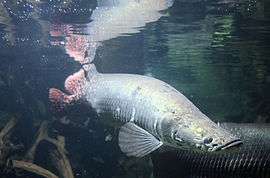Arapaima gigas
| Arapaima gigas | |
|---|---|
 | |
| Scientific classification | |
| Kingdom: | Animalia |
| Phylum: | Chordata |
| Class: | Actinopterygii |
| Order: | Osteoglossiformes |
| Family: | Osteoglossidae |
| Genus: | Arapaima |
| Species: | A. gigas |
| Binomial name | |
| Arapaima gigas (Schinz, 1822) | |
| Synonyms | |
| |
Arapaima gigas, also known as pirarucu,[2] is a species of arapaima native to the basin of the Amazon River. Once believed to be the sole species in the genus, it is among the largest freshwater fish. The species is an obligate air-breather and needs to come to the surface regularly to gulp air.
Taxonomy
Arapaima gigas was originally regarded as the only species in the genus Arapaima, but the subsequent identification of further species, together with the rarity of specimens and the loss of several type specimens, has led to some uncertainty regarding classification within the genus and the identity of described individuals.[3]
Description
The species is among the largest known freshwater fish, commonly measuring 200 centimetres (7 ft) and exceptionally reaching lengths of up to 450 centimetres (15 ft). Adults may weigh up to 200 kilograms or 440 pounds.[4] A. gigas has a streamlined body with dorsal and anal fins set well back towards the tail. While the body is mainly gray to gray-green, its Brazilian local name "pirarucu" derives from an indigenous word for "red fish", thought to refer to either the red flecks on the scales towards the tail, or the reddish-orange colour of its meat.[2]
Distribution
A. gigas is native to freshwater in the basin of the Amazon River; it is known to occur in Brazil, Guyana and Peru.[4][1] The species has been introduced to parts of East Asia, both for fishing purposes and accidentally.[2]
Ecology
A. gigas has the capability to breathe surface air to supplement the oxygen it derives from the use of its gills, and indeed is dependent on surfacing every 5–15 minutes to loudly gulp air at the surface. As in other species in the genus, a modified swim bladder that contains lung-like tissue is used for this purpose.
The species primarily feeds on fish, although juveniles will prefer insects and fish larvae until fully grown.
Spawning occurs in lakes and river channels during the time of low water levels (August to March). After the young hatch from eggs laid in a nest constructed by both parents, the male remains to protect them for a period of about three months. The young reach sexual maturity at an age of four to five years; average life span in captivity is 15–20 years.[2]
Conservation
The species has in the past been heavily impacted by overfishing, exacerbated by their easily exploited habit of surfacing regularly for air-gulping. While arapaima fishing has been banned in Brazil since 2001, illegal fishing is likely continuing, and populations are thought to be declining. The IUCN is currently not assigning a conservation status to A. gigas due to a lack of detailed information about population developments.[2]
References
- 1 2 World Conservation Monitoring Centre (1996). "Arapaima gigas". IUCN Red List of Threatened Species. IUCN. 1996: e.T1991A9110195. Retrieved 29 May 2017.
- 1 2 3 4 5 "Arapaima (Arapaima gigas)". Arkive.org.
- ↑ Stewart, D. J. (2013). "Re-description of Arapaima agassizii (Valenciennes), a rare fish from Brazil (Osteoglossomorpha, Osteoglossidae)". Copeia. 2013: 38–51. doi:10.1643/ci-12-013.
- 1 2 Froese, Rainer and Pauly, Daniel, eds. (2017). "Arapaima gigas" in FishBase. 5 2017 version.
External links
| Wikispecies has information related to Arapaima gigas |
| Wikimedia Commons has media related to Arapaima gigas. |
